News & Views
Civilisations: A Personal View
Johnathan Sunley reflects on the recent television series and the loss of sacred knowledge from the modern world
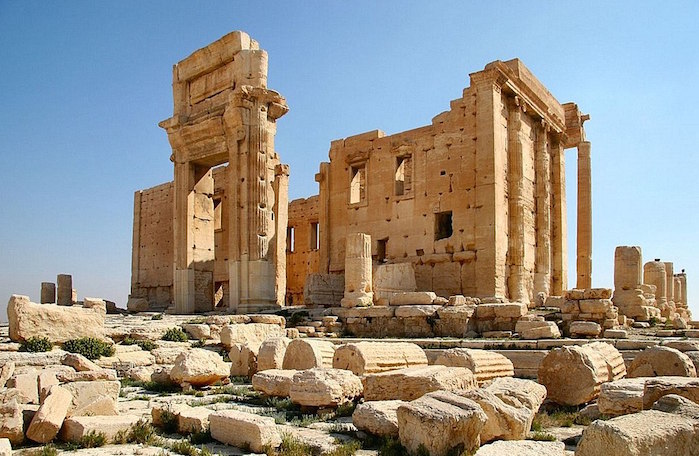
Temple of Bel in Palmyra, Syria, built around 300 CE. Photograph: Zeledi via Wikimedia Commons
Near where I work in central London, on the site of a former hospital, a new garden square has recently come into existence. The grass may be astroturf and the design of the flats and offices that loom over the space less than inspiring. But this is still something of an oasis in a hectic area and one that, being tucked away, never becomes too crowded.
Standing in this square is a massive granite boulder inscribed with letters and symbols from many of the world’s writing systems. Several of these — Cyrillic, Cuneiform, Sanskrit — I am sure will be familiar to readers of Beshara Magazine. Others such as Lycian and Pahlavi I suspect only specialists will be able to recognise. Most of the texts quoted are from ancient creation stories, but a few more modern works are also represented. There is even a line from a play by Beckett written in Morse code.
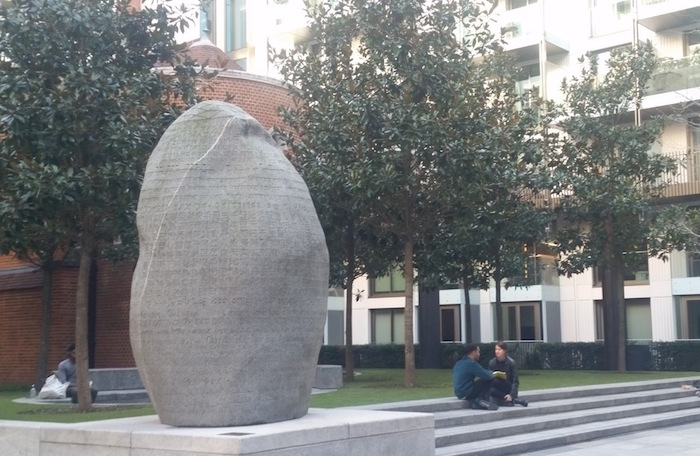
‘The One and the Many’ in Fitzrovia Square, London. Photograph by Johnathan Sunley
The title of this sculpture is ‘The One and the Many’ [/]. I find it impressive and intriguing, and enjoy seeing which scripts I can decipher. But in the end it leaves me cold. Judging by how few people stop to examine this work of art as they walk through the square or take their lunch breaks there, I think I am not alone in feeling this way about it.
The artist, Peter Randall-Page, describes his sculpture as “a celebration of human ingenuity and imagination” – and it is certainly that. What is missing, I would suggest, is any sense of what these capacities are or where they come from. It might be argued that the 24-tonne stone itself has a transcendent quality to it and that this points us towards the source of human creativity. But because every inch of it is covered if not in letters then in glyphs and symbols, in looking at this artwork I find it very hard to have an appreciation of the One. What I usually feel is bewildered and slightly overwhelmed by the profusion of the Many.
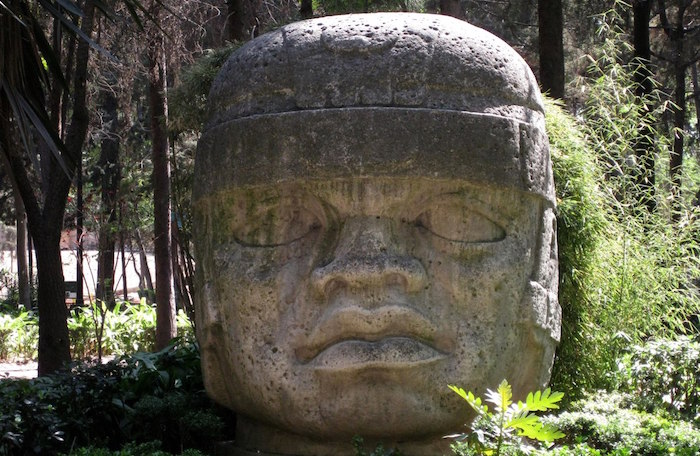
Olmec head located in the Parque Hundido in Mexico City, thought to be 1000–1500BCE. Photograph: John Deckinga via Wiki Media Commons
.
The Civilisations Series
.
I had a similar experience watching last year’s much-hyped BBC television series Civilisations. Over nine programmes, three separate presenters – Mary Beard, David Olusoga and Simon Schama – explored the impact of mankind’s creative imagination from its earliest surviving manifestations in the marks made in a cave in Africa some 80,000 years ago to the most recent output of Anselm Kiefer and Ai Weiwei.
Casting their net as widely as this meant that many of the buildings, artworks and more ordinary objects they showed us are not ones we see on our screens all the time. This was refreshing. I especially liked the Song dynasty scroll paintings from China that the camera lingered over as though unable to take its gaze off their exquisite brushstrokes. (For a short clip of this, click here [/]) And with each episode organised around a theme, as opposed to a particular period or people, we were often reminded of the influence that supposedly discrete cultures and civilisations have on each other. I had no idea, for example, of the competition to construct the world’s greatest dome that went on in the sixteenth century, with Mimar Sinan taking charge of the architecture of the magnificent Süleymaniye Mosque in Istanbul as Michelangelo was attempting to fulfil his last and most challenging commission – the rebuilding of St Peter’s Basilica in Rome. (For a short clip, click here [/])
With much to admire about it, why ultimately did Civilisations prove so disappointing? Audience viewing figures were well below what the BBC had anticipated and the critics were not greatly impressed either. Few thought it matched the series broadcast fifty years earlier, written and presented by the art historian Kenneth Clark. That had been called Civilisation – though Clark himself was never happy with the title and its implication that the narrow, if important, slice of world history on which he based his programmes somehow was civilisation. It would have been better, he wrote later, to have called it: Speculations on the Nature of Civilisation as Illustrated by the Changing Phases of Civilised Life in Western Europe from the Dark Ages to the Present Day.
One of the aims of the more recent series was to give viewers a glimpse of what Clark had left out. In this it succeeded. Whereas Clark only once ventured beyond Europe – in order to comment on the transplantation of Enlightenment values to the New World – watching Civilisations was a bit like being in Doctor Who’s tardis: you had no idea in which part of the globe or historical epoch you would land next. It might be among the colossal stone heads made around 1000 BCE in Mexico by the Olmec. Or it might be on the island of Tahiti, amidst tropical scenery of a kind that had once captivated Gauguin.
Exhilarating though this was at times, I was left feeling disoriented and also with a sense of unease at something more important having been left out. It is hard to say what this is exactly — though I think it is what is lacking from the sculpture I mentioned earlier and the need for which is beautifully expressed in this short verse by Tagore: “Oh, grant me my prayer that I may never lose the touch of the one in the play of the many.”
Perhaps the greatest problem of the age we live in is how little feel it has for what Ibn ʿArabi called ‘the oneness of being’. Pretty much everything is possible. We can have anything, go anywhere, enquire into whatever takes our interest. Only none of this seems to hold together, leaving us restless and dissatisfied and with a longing for something more real – even as we pour our energies into the pursuit of an idea, person or object that will distract us from this state of incompleteness. Seen against this background, Civilisations is very much a product of its time. In my view, it actually says more about our own era – one in which, as Seyyed Hossein Nasr puts it, we are lost in a ‘forest of multiplicity’ – than it does about any of the civilisations that are its subject matter.
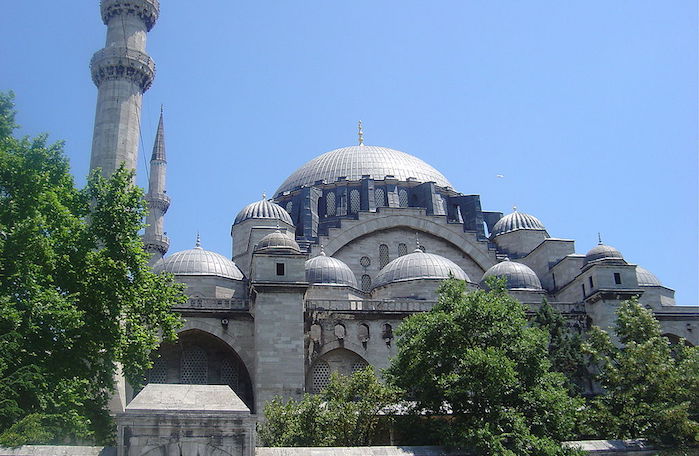
The Süleymaniye Mosque, designed by Sinan, in Istanbul, Turkey. Photograph: DIMSFIKAS via Wikimedia Commons
.
The Meaning of Civilisation
.
To show how dark this forest is, as well as to suggest a way out of it using the light offered by traditional wisdom, I now want to take a closer look at where this potentially promising series went wrong.
One problem is the question of civilisation itself. Do we know what it is? In his opening programme, Clark famously said that he was not sure how to define it in abstract terms but that he could recognise it when he saw it – gesturing across the Seine to the Cathedral of Notre Dame. In the first episode of Civilisations we see the historian Simon Schama taking what seems to be a similar line. We could spend a great deal of time debating what civilisation is, he observes. But there can be no doubt in our minds when its opposite shows up “in all its brutality and cruelty and intolerance and lust for destruction”. He is speaking to camera beside a bust saved from Palmyra and is referring to the attack a few years ago on the ancient city by ISIS and their barbaric execution of its 81-year-old chief curator.
Even if civilisation is being defined here by what it is not rather than by what it is, it is hard to disagree with what Schama says. But this is exactly what one of his co-presenters, the classicist Mary Beard, does in a later episode as she surveys the damage done by Cromwell’s troops in Ely Cathedral (“what they did was basically smash the place up”) along with the assault roughly 100 years earlier on the statues and stained glass of its Lady Chapel. That was not “random vandalism”, Beard tells us, but “focussed even thoughtful destruction” motivated by an abhorrence of idolatry.
I do not want to enter into a debate about iconoclasm. Beard’s programme actually does a reasonable job of exploring this perennial controversy. What interests me is how difficult it was for the series as a whole to agree on what constitutes civilisation, even where what would seem to be the very antithesis of it – systematic violence and destruction – is concerned.
Perhaps this is what the producers of Civilisations intended: to offer viewers a variety of opinions. This would be in keeping with the mores of our relativistic age and might explain why they decided to have three presenters rather than one in the first place. In fact, this seems to have been the overall premise of the series – to serve up a wide variety of civilisations in the hope that we would learn more from this than from a careful study of just one or two cultures ignored by Clark. The effect, however, was the opposite. We came away from these programmes knowing little about the nature of civilisation (which, after all, is as much about ideas, customs and beliefs as it is about the art or technology that express these). And not particularly caring either, for, after a while watching Civilisations, I found myself strangely bored by the ever-changing kaleidoscope of images we were presented with, and confused by a commentary.
It would have helped if the programmes had drawn breath occasionally to contemplate the underlying unity from which all phenomena proceed, that ‘treasury of the Unseen’ as it is sometimes called in Islamic philosophy. Had they done this, they might also have considered the possibility — unfashionable in the West today but at the core of many of the world’s religions — of this process being one of Divine Self-disclosure, whereby, through an unending series of acts of creation and annihilation. God reveals His longing to be known. As it says in the Quran: “Each day He is upon some task.”
Instead, the history of mankind came across as a more-or-less meaningless succession of civilisations, each one rising and falling in turn and connected with all the others only by a thin thread of common preoccupations. According to Schama, there is something tragic about this, as dynasties and priesthoods alike strive to avoid going the way of their predecessors and use art as a kind of talisman against transience. “All civilisations want what they can’t have,” he informs us from among the ruins of a Mayan city surrounded by jungle. “The conquest of time.”
Yet that is not at all the outlook of countless cultures that have flourished on the basis of a distinction drawn between ordinary and sacred time. The latter, it is believed, is when the world was made by the gods. This is not a time in the distant past that has come and gone, but one continually relived in religious rituals and festivals ensuring the renewal of creation – acts of celebration and commemoration, for which the Maya are well known, of course.
Civilisations that view time in this way have no need to conquer it, as Schama supposes, because they know how to escape its endless flow by returning to how things were in the beginning, before time. In other words, they are in touch with the eternal.
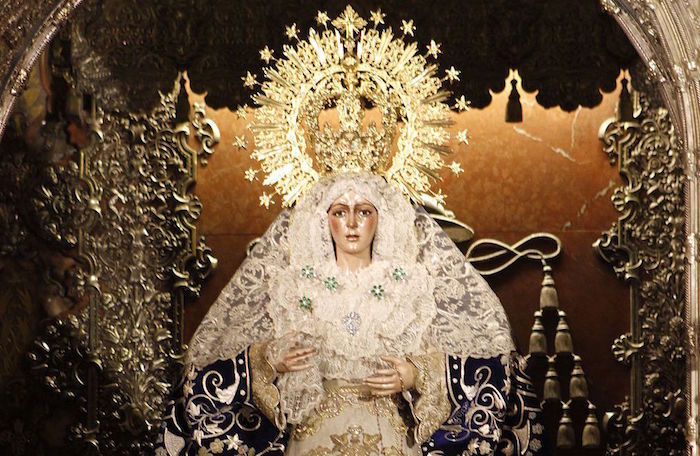
The Virgin of Macarena in Seville, Spain. Photograph: José Luiz Bernardes Ribeiro via Wikimedia Commons
.
A Sense of the Sacred – or Lack of It
.
We live in a secular age with almost no appreciation of what is meant by eternity, and perhaps it was naive to think that Civilisations might look upon our ancestors as having something to teach us in this respect. But it is even more naive to think that a series like this is not offering a teaching of its own when, with imagined impartiality, it presents the past as just one thing after another. For this gives historians the last word on history – and elevates both to a position that it is not for them to occupy. In his book Knowledge and the Sacred, Seyyed Hossein Nasr explains how modern culture has fallen under the spell of the temporal and how much this has cost people in terms of their inner life: “The deification of historical process has become so powerful and such a compelling force that, in the souls of many human beings, it has taken the place of religion.”
For all its limitations, at least with Clark’s series you sense that he is aware of the difference between the sacred and the profane. He recognises the numinous quality that is as likely to be found in functional artefacts as in works of art, and shows his acknowledgement of the divine presence that both are capable of revealing by approaching them in a spirit of respect that sometimes verges on awe. I think you can see this in that sequence at the start of his first episode, where a space which is both literal and symbolic is established by the river separating Clark from the Cathedral of Notre Dame.
For the most part, Civilisations showed no such restraint. Great paintings, sculptures and buildings drew admiration from the presenters, but rarely did you feel they were interested in uncovering timeless essences behind the surfaces of things. The worst offender here was undoubtedly Mary Beard, who insisted on clambering all over some of the objects she was discussing – the sedilia of the Lady Chapel in Ely Cathedral, a gigantic statue of the pharaoh Amenhotep in Egypt – with no regard whatsoever for the reverence in which these had once been held. When she did this in the Basilica of Macarena in Seville, in order to go eyeball to eyeball with the much-venerated wooden image of the Virgin Mary, I couldn’t help asking myself: is nothing sacred?
So, sad to say, there was in the end something rather dispiriting about Civilisations. It showed us lots of wonderful places and artworks that deserve to be better known. And many of the lines of argument it pursued made one think. But at the heart of it there was, well, nothing. Just more camerawork and more commentary with almost no awareness at all of the indescribable oneness of being that gives rise to these as well as everything else that makes up what we call civilisation. Watching the series I was reminded of that sobering line by Traherne from his Centuries of Meditations: “The World is a Mirror of infinite Beauty, yet no Man sees it.”

The three presenters of the Civilisations series: David Olusoga (left), Mary Beard and Simon Schama (right). By kind permission of the Trustees and Director of the National Gallery Titian, ‘Bacchus and Ariadne’ 1520–3 @ The National Gallery, London, Bought, 1826. Photograph: Pete Dabbs/BBC Pictures
Sources (click to open)
.
Related to the Civilisations series
Civilisations Series 1 consisted of nine episodes broadcast on BBC2 between 8 March and 12 May 2019. Click here [/] for information and a series of clips.
The full series is still available on BBC i-player, see
https://www.bbc.co.uk/iplayer/episodes/p05xxp5j
The original series entitled Civilisations by Kenneth Clark consisted of thirteen episodes and was broadcast on BBC2 in 1969. Some episodes are still available on i-player.
Two of the presenters of the 2018 series have written books based upon episodes.
Mary Beard, Civilisations: How Do We Look / The Eye of Faith (Profile Books, 2018)
David Olusoga, Civilisations: First Contact / The Cult of Progress (Profile Books, 2018)
Other Sources
Seyyed Hossein Nasr, Knowledge and the Sacred (State University of New York, 1989)
Thomas Traherne, Centuries of Meditations, (Patianos Classics, 1908)
Johnathan Sunley is a writer and psychotherapist living in London.
More News & Views
Introducing… ‘Perfect Days’ and ‘Nowhere Special’
Jane Clark watches two films with a contemplative theme
Irreducible: Consciousness, Life, Computers and Human Nature
Richard Gault reviews a new book by one of the leading lights of the science of consciousness
An Irish Atlantic Rainforest
Peter Mabey reviews a new book by Eoghan Daltun which presents an inspiring example of individual action in the face of climate change
In Memory of Bill Viola (1951–2024)
Jane Carroll pays tribute to the acclaimed video artist, who died on July 12th 2024
Bringing More Land Back to Life
Luci Attala gives an update on the Kogi’s exciting regeneration project, Munekan Masha, in Colombia
Wild Service: Why Nature Needs You
Charlotte Maberly reviews a new book that argues that it is only by including human beings in nature that we can preserve it
FOLLOW AND LIKE US
——————————————
——————————————
——————————————
If you enjoyed reading this article
Please leave a comment below.
Please also consider making a donation to support the work of Beshara Magazine. The magazine relies entirely on voluntary support. Donations received through this website go towards editorial expenses, eg. image rights, travel expenses, and website maintenance and development costs.
READERS’ COMMENTS
1 Comment
Submit a Comment
FOLLOW AND LIKE US
Thanks. The critique is so clearly seen and expressed. Schama is, in a way, the most interesting case in point as he can talk brilliantly about colour and light, and yet doesn’t quite have the language for oneness and eternity.